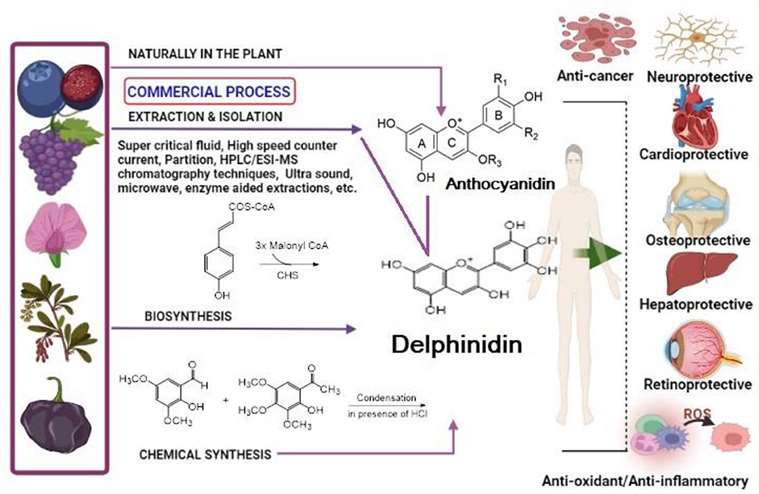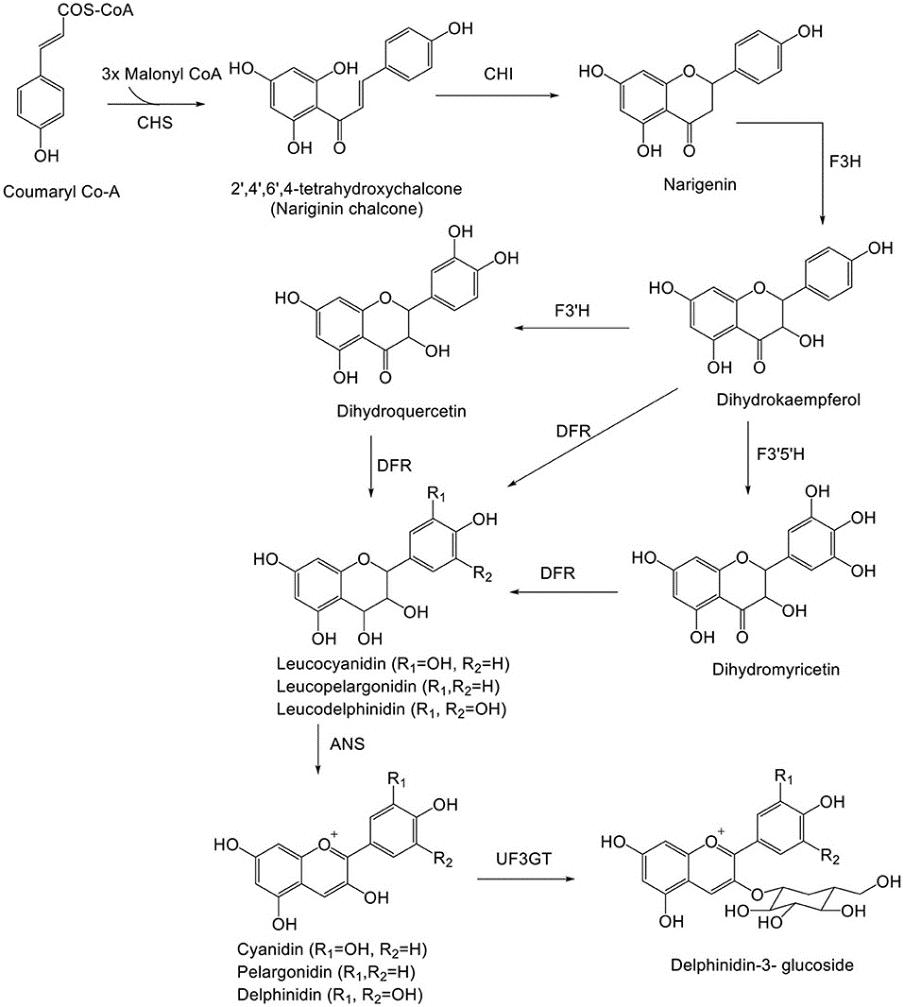What is Delphinidin?
Delphinidin, classified as a flavonoid anthocyanidin, represents a vital component of the plant kingdom's pigmentation palette, responsible for imparting vibrant blue to violet hues in various fruits, vegetables, and flowers. Structurally, delphinidin features a core C6-C3-C6 skeleton, characterized by two aromatic rings (A and B) connected by a heterocyclic ring (C), adorned with hydroxyl (-OH) and methoxy (-OCH3) groups at specific positions.
Beyond its role in pigmentation, delphinidin exhibits a plethora of biological activities, ranging from antioxidant and anti-inflammatory properties to potential anticancer effects. Research suggests its involvement in mitigating oxidative stress, scavenging free radicals, and modulating cellular signaling pathways, thereby conferring protective effects against various chronic diseases.
Creative Proteomics offers a one-stop tailored delphinidin analysis service to meet the diverse needs of researchers and industries. Our team provides accurate and reliable data to support research, development and quality control programs.
Delphinidin Analysis Offered by Creative Proteomics
Delphinidin Content Determination: Quantification of delphinidin content in various samples using high-performance liquid chromatography (HPLC) or mass spectrometry (MS) techniques.
Delphinidin Metabolite Profiling: Identification and quantification of delphinidin metabolites in biological samples to understand metabolic pathways and bioavailability.
Delphinidin Binding Assays: Investigation of delphinidin interactions with target proteins or receptors using techniques such as surface plasmon resonance (SPR) or fluorescence spectroscopy.
Delphinidin Bioactivity Studies: Assessment of the biological activities of delphinidin, including antioxidant, anti-inflammatory, and anticancer properties, through cell-based assays or animal studies.
Technological Platforms for Delphinidin Analysis
High-Performance Liquid Chromatography (HPLC): HPLC separates compounds based on their interaction with stationary and mobile phases, offering high resolution and versatility, with instruments like the Agilent 1260 Infinity II HPLC System and Waters Alliance HPLC System.
Liquid Chromatography-Mass Spectrometry (LC-MS): LC-MS combines liquid chromatography's separation power with mass spectrometry's detection capabilities, enabling sensitive and specific compound identification, using instruments such as the Agilent 1290 Infinity II LC System coupled with Agilent 6550 iFunnel Q-TOF LC/MS System and Thermo Scientific Q Exactive HF-X Hybrid Quadrupole-Orbitrap Mass Spectrometer.
Gas Chromatography-Mass Spectrometry (GC-MS): GC-MS separates volatile compounds and semi-volatile compounds, followed by mass spectrometric detection, providing high sensitivity and specificity, with instruments like the Agilent 7890B Gas Chromatograph coupled with Agilent 5977B Mass Selective Detector and Shimadzu GCMS-QP2020 NX Gas Chromatograph-Mass Spectrometer.
Nuclear Magnetic Resonance (NMR) Spectroscopy: NMR spectroscopy provides detailed structural information based on compounds' interaction with a magnetic field, offering high resolution and non-destructive analysis, with instruments like the Bruker AVANCE III HD NMR Spectrometer and JEOL ECZ 500R NMR Spectrometer.
Spectrophotometry: Spectrophotometric methods measure compounds' absorbance of light at specific wavelengths, offering simplicity and speed for quantitative analysis, with instruments such as the Thermo Scientific Evolution 201 UV-Visible Spectrophotometer and Shimadzu UV-2600 UV-Vis Spectrophotometer.
High-Resolution Mass Spectrometry (HRMS): HRMS provides accurate mass determination for precise compound identification and characterization, offering high resolution and mass accuracy, with instruments like the Thermo Scientific Orbitrap Fusion Lumos Tribrid Mass Spectrometer and Bruker maXis Impact QTOF Mass Spectrometer.
 Workflow for Plant Metabolomics Service
Workflow for Plant Metabolomics Service
Sample Requirements for Delphinidin Assay
| Sample Type |
Recommended Sample Amount |
| Fruit (e.g., berries) |
10-50 grams |
| Vegetable (e.g., purple cabbage) |
10-50 grams |
| Flower (e.g., viola) |
5-20 grams |
| Extract (e.g., purified delphinidin) |
1-10 milligrams |
| Beverage (e.g., red wine) |
50-100 milliliters |
| Serum/Plasma |
0.5-1 milliliter |
| Urine |
10-50 milliliters |
| Tissue (e.g., plant tissue) |
0.1-1 gram |
| Cell culture |
1-10 million cells |
| Sample Type |
Recommended Sample Amount |
Applications of Delphinidin Analysis
Food Science and Nutrition:
- Quality Control: Assessing delphinidin content in fruits, vegetables, and beverages to determine their nutritional value and antioxidant capacity.
- Food Processing: Monitoring changes in delphinidin levels during food processing and storage to optimize preservation methods and maintain nutritional quality.
- Functional Foods: Incorporating delphinidin-rich ingredients into functional foods and dietary supplements for their potential health benefits.
Pharmaceuticals and Medicine:
- Drug Development: Studying delphinidin as a potential therapeutic agent for its anti-inflammatory, anti-cancer, and cardioprotective properties.
- Pharmacokinetics: Analyzing delphinidin metabolism and bioavailability to understand its pharmacological effects and optimize drug formulations.
- Natural Health Products: Evaluating delphinidin-containing botanical extracts and herbal remedies for their efficacy in promoting health and treating various ailments.
Biomedical Research:
- Disease Biomarkers: Investigating delphinidin levels as potential biomarkers for assessing oxidative stress, inflammation, and chronic diseases such as cardiovascular disease and cancer.
- Cellular Signaling: Studying delphinidin's effects on cellular signaling pathways involved in inflammation, apoptosis, and cell proliferation to elucidate its mechanisms of action.
Cosmetics and Personal Care:
- Skin Health: Assessing the role of delphinidin in protecting against UV-induced skin damage, reducing inflammation, and promoting collagen synthesis for potential use in skincare products.
- Hair Care: Investigating delphinidin's antioxidant properties and its ability to protect hair follicles from oxidative stress and damage.
Environmental Science:
- Environmental Monitoring: Analyzing delphinidin levels in environmental samples such as soil, water, and air to assess environmental pollution and its potential impact on human health and ecosystems.
- Phytoremediation: Studying plants containing delphinidin for their ability to absorb and detoxify pollutants from the environment, contributing to sustainable remediation strategies.
Case. The Multifaceted Health Benefits of Delphinidin (Dp)
Background
Delphinidin (Dp), a type of anthocyanin found in various fruits and vegetables, has gained attention for its potential health benefits. Preclinical and clinical studies have explored its diverse pharmacological effects, including antidiabetic, anti-osteoporotic, anti-psoriatic, anti-hepatotoxic, and anti-viral activities.

Sample
The studies encompassed in vitro experiments using cell lines such as colon cancer cells (HCT116), prostate cancer cells (LNCaP), lung cancer cells, osteoclast precursors (RAW 264.7 cells), osteoblast precursor cell line (MC3T3-E1), chondrocytes, and normal human epidermal keratinocytes (NHEK). In vivo studies involved animal models including mice and rats.
 Biosynthetic pathway of delphinidin.
Biosynthetic pathway of delphinidin.
Technical Methods
Antidiabetic Activity: Various techniques were employed to assess the antidiabetic effects of Dp, including measurement of blood glucose levels, insulin levels, and GLP-1 secretion. Techniques such as HPLC analysis were used to identify degradation products of Dp-3-rutinoside (Dp-3-R) and their effects on GLP-1 secretion. Additionally, gene and protein expression analysis elucidated the molecular mechanisms underlying Dp's antidiabetic effects.
Anti-osteoporotic Activity: In vitro experiments utilized techniques like cell culture assays to evaluate osteoclast formation and gene expression analysis to assess the modulation of NF-κB pathway. In vivo studies employed X-ray analysis to assess bone deterioration and histopathological examination to evaluate bone morphology. TransAM assay was utilized to investigate the inhibition of osteoclast differentiation by Dp.
Role in Skeletal Muscle Atrophic Activity: Techniques such as RT-qPCR and Western blotting were used to measure gene and protein expression levels related to muscle atrophy. In vitro cell culture assays and in vivo experiments in mice were conducted to assess the effects of Dp on muscle weight loss and expression of genes involved in muscle protein degradation.
Anti-psoriatic Activity: Cell viability assays and apoptosis assays were performed to evaluate the effects of Dp on keratinocytes. In vivo studies involved topical application of Dp on mice with psoriasis-like lesions, followed by histopathological analysis and measurement of inflammatory cytokine levels. In silico docking studies were conducted to explore the molecular interactions of Dp with relevant proteins.
Anti-hepatotoxic and Anti-viral Activity: Various techniques such as immunohistochemistry, biochemical assays, and histopathological analysis were employed to assess the hepatoprotective effects of Dp against liver damage induced by toxins. In vitro assays were used to evaluate the inhibitory effects of Dp on hepatitis C virus (HCV) entry and viral RNA expression. Computational approaches including structure-based virtual screening were utilized to explore the potential of Dp as an inhibitor of SARS-CoV2 main protease.
Results
The studies collectively demonstrate the diverse pharmacological activities of Dp, including its efficacy in controlling blood glucose levels, preventing bone loss, mitigating muscle atrophy, treating psoriasis, protecting against liver damage, and inhibiting viral infections. These findings underscore the potential of Dp as a therapeutic agent for various health conditions.
Reference
- Husain, Asif, et al. "Chemistry and pharmacological actions of delphinidin, a dietary purple pigment in anthocyanidin and anthocyanin forms." Frontiers in nutrition 9 (2022): 746881.


 Workflow for Plant Metabolomics Service
Workflow for Plant Metabolomics Service
 Biosynthetic pathway of delphinidin.
Biosynthetic pathway of delphinidin.